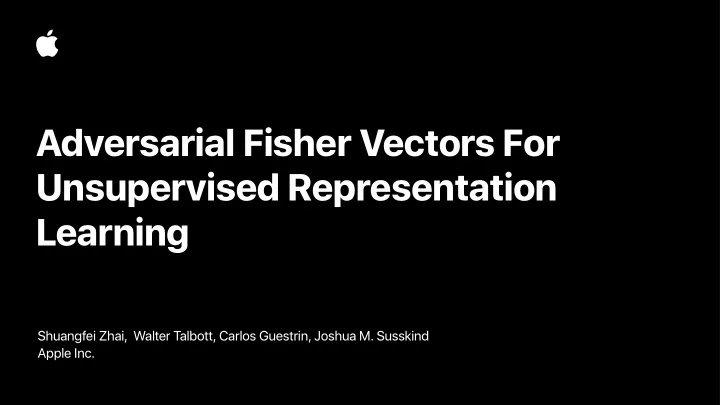

Adversarial Fisher Vectors For Unsupervised Representation Learning Shuangfei Zhai, Walter Talbott, Carlos Guestrin, Joshua M. Susskind Apple Inc.
Questions about GANs • Is the discriminator useful at test time? • Do GANs learn representations of data? • Do you need to train an additional encoder?
Energy Based Model Interpretation of GANs • The WGAN formulation max G min D E x ∼ p data ( x ) [ − D ( x )] + E z ∼ p ( z ) [ D ( G ( z ))] (1) • EBM with variational training has a dual form to a WGAN e D ( x ) min D max G E x ∼ p data ( x ) [ − D ( x )] + E z ∼ p ( z ) [ D ( G ( z ))] + Entropy ( p G ), s . t . p ( x ) = (2) ∫ x e D ( x ) dx • Equation (1) and (2) can amount to the same practical implementation! Generative Adversarial Networks as Variational Training of Energy Based Models, Zhai et. al.
Fisher Vectors • Fisher vectors provide a way to represent an example given a probabilistic model V x = I − 1 2 ∇ θ log p θ ( x ), s . t . , I = E x ∼ p θ ( x ) [ ∇ θ log p θ ( x ) ∇ θ log p θ ( x ) T ] • Has seen successful applications in computer vision image SIFT descriptor Gaussian Mixture Model FV Exploiting Generative Models In Discriminative Classifiers, Jaakkola and Haussler
Adversarial Fisher Vectors • Step 1: train a GAN and treat it as an EBM • Step 2: compute the Adversarial Fisher Vector via: V x = ( diag (I) − 1 2 ) U x s . t . U x = ∇ θ D ( x ; θ ) − E z ∼ p ( z ) ∇ θ D ( G ( z ); θ ), I = E z ∼ p ( z ) [ U G ( z ) U T G ( z ) ] V x • Step 3: use as the representation for downstream tasks (e.g., classification)
State-of-the-art Results on Linear Classification
Checkout the Paper and Code!
Recommend
More recommend